Analyzing the Spatio-Temporal Dynamics of Urban Land Use Expansion and Its Influencing Factors in Zhejiang Province, China
Abstract
1. Introduction
2. Study Area and Data Sources
2.1. The Study Area
2.2. Sources of Data
2.3. Variable Selection
3. Research Methodology
3.1. Framework of the Study
3.2. Space Weight Matrix
3.2.1. Queen Contiguity Weight
3.2.2. Geographic Distance Weight
3.3. Spatial Autocorrelation Test
3.3.1. Global Spatial Autocorrelation
3.3.2. Local Spatial Autocorrelation
3.4. Spatial Econometric Model
4. Results
4.1. Outcome of the Spatial Autocorrelation
4.1.1. Global Spatial Autocorrelation Results
4.1.2. Local Spatial Autocorrelation Result
4.2. Urban Land Use Expansion in Zhejiang Province from 1990 to 2020
4.3. Contributions of Other Land Uses to Built-Up Area Expansion
4.4. Spatial Distribution of Built-Up Area Development
5. Analysis of the Drivers/Influencing Factors of Built-Up Area Expansion
5.1. Selection of Regression Models
5.2. Analysis of Spatial Effects
5.3. Further Analysis of Different Study Periods
5.4. Further Analysis of Different Regions
6. Conclusions
7. Recommendations
- (i)
- The expansion of urban construction land is inevitable and important. We oppose inefficient and disorderly land development, but we also support the further expansion of construction land in some areas that already have the advantage of urbanization. For example, core big cities should play a leading role in economic development and become key development zones. However, in places far away from big cities and with remote physical and geographical conditions, especially in mountainous areas, more ecological protection functions should be employed. In this way, sustainable development can be achieved in a wider range.
- (ii)
- Policymakers should break through administrative boundaries and coordinate regional development from a higher and more comprehensive perspective. Taking Zhejiang Province as an example, priority should be given to the development of the four metropolitan areas in Zhejiang Province, breaking through the restrictions of administrative barriers regarding the flow of economic resource elements, optimizing the urban spatial system, and realizing the coordinated development of large, medium, and small cities.
- (iii)
- The transformation and upgrading of the industrial structure should be accelerated. Developing tertiary industry can also be seen as an effective way to ease the conflict between cultivated land and construction land in developing countries. Our analysis indicates the positive effect of the development of the tertiary industry on improving land use efficiency and thus slowing down the occupation of farmland in Zhejiang. Therefore, we should vigorously promote the transformation of traditional industries into ecological, scientific, and service industries.
Author Contributions
Funding
Data Availability Statement
Conflicts of Interest
References
- Schneider, A.; Mertes, C.M. Expansion and growth in Chinese cities, 1978–2010. Environ. Res. Lett. 2014, 9, 024008. [Google Scholar] [CrossRef]
- Wei, H.; Li, L.; Nian, M. China’s Urbanization Strategy and Policy During the 14th Five-Year Plan Period. Chin. J. Urban Environ. Stud. 2021, 9, 2150002. [Google Scholar] [CrossRef]
- Seto, K.C.; Fragkias, M.; Güneralp, B.; Reilly, M.K. A Meta-Analysis of Global Urban Land Expansion. PLoS ONE 2011, 6, e23777. [Google Scholar] [CrossRef]
- Bai, X.; Shi, P.; Liu, Y. Society: Realizing China’s Urban Dream. Nature 2014, 509, 158–160. [Google Scholar] [CrossRef]
- Xu, M.; He, C.; Liu, Z.; Dou, Y. How Did Urban Land Expand in China between 1992 and 2015? A Multi-Scale Landscape Analysis. PLoS ONE 2016, 11, e0154839. [Google Scholar] [CrossRef] [PubMed]
- He, C.; Gao, B.; Huang, Q.; Ma, Q.; Dou, Y. Environmental degradation in the urban areas of China: Evidence from multi-source remote sensing data. Remote Sens. Environ. 2017, 193, 65–75. [Google Scholar] [CrossRef]
- Song, X.; Liu, Y.; Zhu, X.; Cao, G.; Chen, Y.; Zhang, Z.; Wu, D. The impacts of urban land expansion on ecosystem services in Wuhan, China. Environ. Sci. Pollut. Res. Int. 2022, 29, 10635–10648. [Google Scholar] [CrossRef]
- Zhu, C.; Lin, Y.; Zhang, J.; Gan, M.; Xu, H.; Li, W.; Yuan, S.; Wang, K. Exploring the relationship between rural transition and agricultural eco-environment using a coupling analysis: A case study of Zhejiang Province, China. Ecol. Indic. 2021, 127, 107733. [Google Scholar] [CrossRef]
- Shao, Z.; Bakker, M.; Spit, T.; Janssen-Jansen, L.; Qun, W. Containing urban expansion in China: The case of Nanjing. J. Environ. Plan. Manag. 2020, 63, 189–209. [Google Scholar] [CrossRef]
- Gong, P.; Li, X.; Zhang, W. 40-Year (1978–2017) human settlement changes in China reflected by impervious surfaces from satellite remote sensing. Sci. Bull. 2019, 64, 756–763. [Google Scholar] [CrossRef]
- Zhang, S.; Wei, L.; Jin, X.; Lu, Y. The Land Use Simulation and Delimitation of Urban Development Boundary in County Area based on FLUS-UGB. J. Geo-Inf. Sci. 2020, 22, 1848. [Google Scholar] [CrossRef]
- Yang, J.; Huang, X. The 30 m annual land cover dataset and its dynamics in China from 1990 to 2019. Earth Syst. Sci. Data 2021, 13, 3907–3925. [Google Scholar] [CrossRef]
- Zhuang, H.; Chen, G.; Yan, Y.; Li, B.; Zeng, L.; Ou, J.; Liu, K.; Liu, X. Simulation of urban land expansion in China at 30 m resolution through 2050 under shared socioeconomic pathways. GISci. Remote Sens. 2022, 59, 1301–1320. [Google Scholar] [CrossRef]
- Li, C.; Wu, K.; Wu, J. Urban land use change and its socio-economic driving forces in China: A case study in Beijing, Tianjin and Hebei region. Environ. Dev. Sustain. 2018, 20, 1405–1419. [Google Scholar] [CrossRef]
- Wang, L.; Zhang, S.; Liu, Y.; Liu, Y. Interaction between Construction Land Expansion and Cropland Expansion and Its Socioeconomic Determinants: Evidence From Urban Agglomeration in the Middle Reaches of the Yangtze River, China. Front. Environ. Sci. 2022, 10, 882582. [Google Scholar] [CrossRef]
- Cai, W.; Fangyuan, T. Spatiotemporal characteristics and driving forces of construction land expansion in Yangtze River economic belt, China. PLoS ONE 2020, 15, e0227299. [Google Scholar] [CrossRef]
- Niu, B.; Ge, D.; Yan, R.; Ma, Y.; Sun, D.; Lu, M.; Lu, Y. The Evolution of the Interactive Relationship between Urbanization and Land-Use Transition: A Case Study of the Yangtze River Delta. Land 2021, 10, 804. [Google Scholar] [CrossRef]
- Liu, Z.; Huang, H.; Werners, S.E.; Yan, D. Construction area expansion in relation to economic-demographic development and land resource in the Pearl River Delta of China. J. Geogr. Sci. 2016, 26, 188–202. [Google Scholar] [CrossRef]
- Wu, J.; Li, X.; Luo, Y.; Zhang, D. Spatiotemporal effects of urban sprawl on habitat quality in the Pearl River Delta from 1990 to 2018. Sci. Rep. 2021, 11, 13981. [Google Scholar] [CrossRef]
- Du, J.; Thill, J.-C.; Peiser, R.B.; Feng, C. Urban land market and land-use changes in post-reform China: A case study of Beijing. Landsc. Urban Plan. 2014, 124, 118–128. [Google Scholar] [CrossRef]
- Zhang, W.; Li, B. Research on an Analytical Framework for Urban Spatial Structural and Functional Optimisation: A Case Study of Beijing City, China. Land 2021, 10, 86. [Google Scholar]
- Wang, R.; Yang, Y. Driving Forces of Land Use/Cover Change and Urban Construction Land Conversion: A Case Study of Tianjin. IOP Conf. Ser. Earth Environ. Sci. 2019, 237, 032040. [Google Scholar] [CrossRef]
- Li, X.; Liu, Z.; Li, S.; Li, Y. Multi-Scenario Simulation Analysis of Land Use Impacts on Habitat Quality in Tianjin Based on the PLUS Model Coupled with the InVEST Model. Sustainability 2022, 14, 6923. [Google Scholar] [CrossRef]
- Liang, Z.; Xuewei, D.; Qinke, S.; Shaohua, W. Multi-scenario simulation of urban land change in Shanghai by random forest and CA-Markov model. Sustain. Cities Soc. 2020, 55, 102045. [Google Scholar] [CrossRef]
- Shi, Y.; Wu, J.; Shi, S. Study of the Simulated Expansion Boundary of Construction Land in Shanghai Based on a SLEUTH Model. Sustainability 2017, 9, 876. [Google Scholar]
- Wang, Q.; Wang, H.; Chang, R.; Zeng, H.; Bai, X. Dynamic simulation patterns and spatiotemporal analysis of land-use/land-cover changes in the Wuhan metropolitan area, China. Ecol. Model. 2022, 464, 109850. [Google Scholar] [CrossRef]
- Zhai, H.; Lv, C.; Liu, W.; Yang, C.; Fan, D.; Wang, Z.; Guan, Q. Understanding Spatio-Temporal Patterns of Land Use/Land Cover Change under Urbanization in Wuhan, China, 2000–2019. Remote Sens. 2021, 13, 3331. [Google Scholar] [CrossRef]
- Deng, J.S.; Wang, K.; Hong, Y.; Qi, J.G. Spatio-temporal dynamics and evolution of land use change and landscape pattern in response to rapid urbanization. Landsc. Urban Plan. 2009, 92, 187–198. [Google Scholar] [CrossRef]
- Xu, H.; Song, Y.; Tian, Y. Simulation of land-use pattern evolution in hilly mountainous areas of North China: A case study in Jincheng. Land Use Policy 2022, 112, 105826. [Google Scholar] [CrossRef]
- Luo, T.; Tan, R.; Kong, X.; Zhou, J. Analysis of the Driving Forces of Urban Expansion Based on a Modified Logistic Regression Model: A Case Study of Wuhan City, Central China. Sustainability 2019, 11, 2207. [Google Scholar] [CrossRef]
- Feng, Y.; Wang, X.; Du, W.; Liu, J.; Li, Y. Spatiotemporal characteristics and driving forces of urban sprawl in China during 2003–2017. J. Clean. Prod. 2019, 241, 118061. [Google Scholar] [CrossRef]
- Zhou, L.; Pan, A.; Luo, F. Spatial-temporal evolution and driving forces of construction land expansion in Chengdu from 1980 to 2018. J. Southwest For. Univ. 2023, 43, 1–9. [Google Scholar] [CrossRef]
- Wang, X.; Peng, L.; Liu, S.J.; Wei, Y. Characteristics and the driving mechanism of urban construction land expansion in mountainous areas of southwest China. Chin. J. Ecol. 2021, 40, 2895–2903. [Google Scholar] [CrossRef]
- Chen, C.; Feng, C. Driving Forces for Construction Land Expansion in China. China Popul. Resour. Environ. 2010, 10, 72–78. [Google Scholar]
- Wu, R.; Li, Z.; Wang, S. The varying driving forces of urban land expansion in China: Insights from a spatial-temporal analysis. Sci. Total Environ. 2021, 766, 142591. [Google Scholar] [CrossRef]
- Chufu, M.; Wang, L.; Qu, Q.; Yebing, F.; Hong, Z. Factors Driving the Expansion of Construction Land: A Panel Data Study of Districts and Counties in Ningbo City, China. J. Resour. Ecol. 2018, 9, 365–373. [Google Scholar] [CrossRef]
- Zhou, Y.; Li, X.; Liu, Y. Land use change and driving factors in rural China during the period 1995–2015. Land Use Policy 2020, 99, 105048. [Google Scholar] [CrossRef]
- Zhang, M.; Tan, S.; Zhang, X. How do varying socio-economic factors affect the scale of land transfer? Evidence from 287 cities in China. Environ. Sci. Pollut. Res. 2022, 29, 40865–40877. [Google Scholar] [CrossRef]
- Ma, Q.; He, C.; Wu, J. Behind the rapid expansion of urban impervious surfaces in China: Major influencing factors revealed by a hierarchical multiscale analysis. Land Use Policy 2016, 59, 434–445. [Google Scholar] [CrossRef]
- Fan, X.; Zheng, D.; Shi, M. How Does Land Development Promote China’s Urban Economic Growth? The Mediating Effect of Public Infrastructure. Sustainability 2016, 8, 279. [Google Scholar] [CrossRef]
- Zhao, K.; Zhang, A.-L.; Ping, L. Driving Forces of Urban Construction Land Expansion: An Empirical Analysis Based on Panel Data of Provinces. J. Nat. Resour. 2011, 26, 1323–1332. [Google Scholar] [CrossRef]
- Li, Y.; Xiong, W. A spatial panel data analysis of China’s urban land expansion, 2004–2014. Pap. Reg. Sci. 2019, 98, 393–407. [Google Scholar] [CrossRef]
- Zhang, P.; Li, Y.; Jing, W.; Yang, D.; Zhang, Y.; Liu, Y.; Geng, W.; Rong, T.; Shao, J.; Yang, J.; et al. Comprehensive Assessment of the Effect of Urban Built-up Land Expansion and Climate Change on Net Primary Productivity. Complexity 2020, 2020, 8489025. [Google Scholar] [CrossRef]
- Liang, X.; Liu, X.; Li, X.; Chen, Y.; Tian, H.; Yao, Y. Delineating multi-scenario urban growth boundaries with a CA-based FLUS model and morphological method. Landsc. Urban Plan. 2018, 177, 47–63. [Google Scholar] [CrossRef]
- Liu, X.; Wei, M.; Li, Z.; Zeng, J. Multi-scenario simulation of urban growth boundaries with an ESP-FLUS model: A case study of the Min Delta region, China. Ecol. Indic. 2022, 135, 108538. [Google Scholar] [CrossRef]
- Lian, H.; He, L.; Zhang, W. Driving Factors and Divergency of Urban Construction Land Expansion in China: An Empirical Analysis Based on Panel Data of 35 Large and Medium-sized Cities. J. Beijing Norm. Univ. Soc. Sci. 2021, 3, 46–57. [Google Scholar]
- Liu, Y.; Ceng, H.; Sun, W. Analysis on the regional differences and driving factors of urban construction land expansion. China Popul. Resour. Environ. 2017, 27, 122–127. [Google Scholar]
- Liu, S.; Ye, Y.; Zhong, S. Research on Shift Route of Gravity Center and Decoupling Relationship between Urban Land Expansion and Economic Growth in China. Resour. Environ. Yangtze Basin 2020, 29, 2563–2571. [Google Scholar]
- Brady, M.; Irwin, E. Accounting for Spatial Effects in Economic Models of Land Use: Recent Developments and Challenges Ahead. Environ. Resour. Econ. 2011, 48, 487–509. [Google Scholar] [CrossRef]
- Overmars, K.P.; de Koning, G.H.J.; Veldkamp, A. Spatial autocorrelation in multi-scale land use models. Ecol. Model. 2003, 164, 257–270. [Google Scholar] [CrossRef]
- Wang, J. A Spatial-panel Econometric Analysis on the Relationship between Regional Socio-economic Development and Construction Land Use in China. China Land Sci. 2013, 27, 79–85. [Google Scholar]
- Chen, Y.; Zhu, H.; Zhu, Y.; Li, Y. Driving Mechanism Analysis of Provincial Construction Land Expansion Based on Panel Data. Territ. Nat. Resour. Study 2016, 2, 17–20. [Google Scholar]
- Tang, Z.; Zhang, Z.; Zuo, L.; Wang, X.; Hu, S.; Zhu, Z. Spatial Econometric Analysis of the Relationship between Urban Land and Regional Economic Development in the Beijing–Tianjin–Hebei Coordinated Development Region. Sustainability 2020, 12, 8451. [Google Scholar]
- He, C.; Huang, Z.; Wang, R. Land use change and economic growth in urban China: A structural equation analysis. Urban Stud. 2014, 51, 2880–2898. [Google Scholar] [CrossRef]
- Deng, X.; Huang, J.; Rozelle, S.; Uchida, E. Economic Growth and the Expansion of Urban Land in China. Urban Stud. 2010, 47, 813–843. [Google Scholar] [CrossRef]
- Xu, X.; Zhou, Y.; Ning, Y. Urban Geography; Higher Education Press: Beijing, China, 2009. [Google Scholar]
- Shoshany, M.; Goldshleger, N. Land-use and population density changes in Israel—1950 to 1990: Analysis of regional and local trends. Land Use Policy 2002, 19, 123–133. [Google Scholar] [CrossRef]
- Liang, Y.; Cai, W.; Ma, M. Carbon dioxide intensity and income level in the Chinese megacities’ residential building sector: Decomposition and decoupling analyses. Sci. Total Environ. 2019, 677, 315–327. [Google Scholar] [CrossRef]
- Wei, Y.D. Zone Fever, Project Fever: Development Policy, Economic Transition, and Urban Expansion in China. Geogr. Rev. 2015, 105, 156–177. [Google Scholar] [CrossRef]
- Gao, J.; Wei, Y.D.; Chen, W.; Chen, J. Economic transition and urban land expansion in Provincial China. Habitat Int. 2014, 44, 461–473. [Google Scholar] [CrossRef]
- Leenders, R.T.A.J. Modeling social influence through network autocorrelation: Constructing the weight matrix. Soc. Netw. 2002, 24, 21–47. [Google Scholar] [CrossRef]
- Elhorst, J.P. Spatial Econometrics, 1st ed.; Springer: Berlin/Heidelberg, Germany, 2014. [Google Scholar] [CrossRef]
- Berry, B.J.L.; Marble, D.F. Spatial Analysis. A Reader in Statistical Geography; Prentice Hall: Englewood Cliffs, NJ, USA, 1968. [Google Scholar]
- Tobler, W.R. A Computer Movie Simulating Urban Growth in the Detroit Region. Econ. Geogr. 1970, 46, 234–240. [Google Scholar] [CrossRef]
- Herrera, M.; Mur, J.; Ruiz, M. A Comparison Study on Criteria to Select the Most Adequate Weighting Matrix. Entropy 2019, 21, 160. [Google Scholar] [PubMed]
- Goodchild, M.; Haining, R.; Wise, S. Integrating GIS and Spatial Data Analysis—Problems and Possibilities. Int. J. Geogr. Inf. Sci. 1992, 6, 407–423. [Google Scholar] [CrossRef]
- Anselin, L. Spatial Econometrics: Methods and Models; Springer: Dordrecht, The Netherlands, 1988. [Google Scholar] [CrossRef]
- LeSage, J.P.; Pace, R.K. Introduction to Spatial Econometrics; Chapman and Hall CRC: New York, NY, USA, 2009. [Google Scholar] [CrossRef]
- Pandey, B.; Seto, K.C. Urbanization and agricultural land loss in India: Comparing satellite estimates with census data. J. Environ. Manag. 2015, 148, 53–66. [Google Scholar] [CrossRef]
- Wu, K.-Y.; Zhang, H. Land use dynamics, built-up land expansion patterns, and driving forces analysis of the fast-growing Hangzhou metropolitan area, eastern China (1978–2008). Appl. Geogr. 2012, 34, 137–145. [Google Scholar] [CrossRef]
- Mengxing, L.; Zhangchun, F. Study on the Change of Urban Construction Land and the Different Driving Force in Beijing-Tianjin-and Hebei Region. Urban Dev. Stud. 2018, 25, 23–28. [Google Scholar]

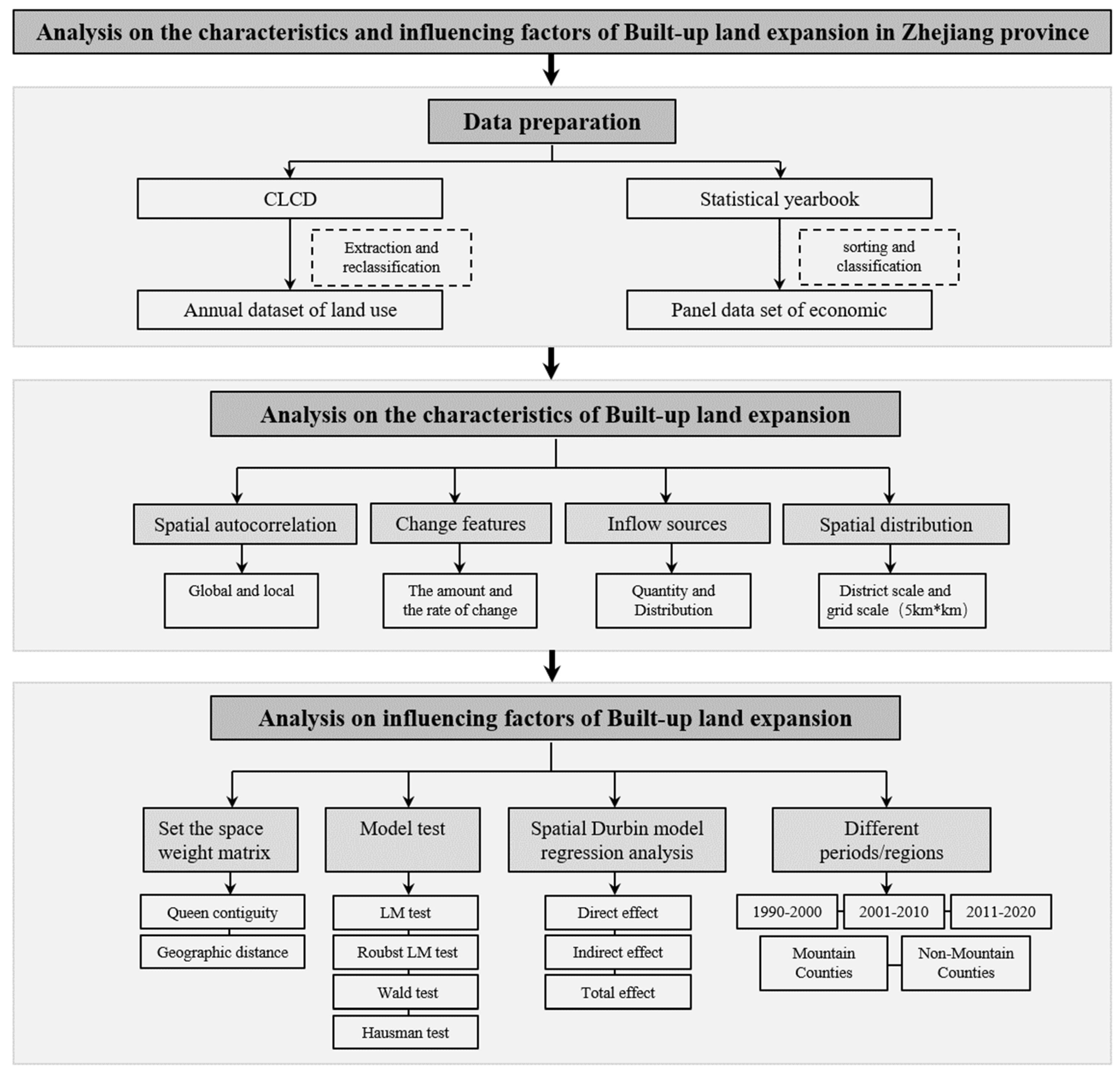
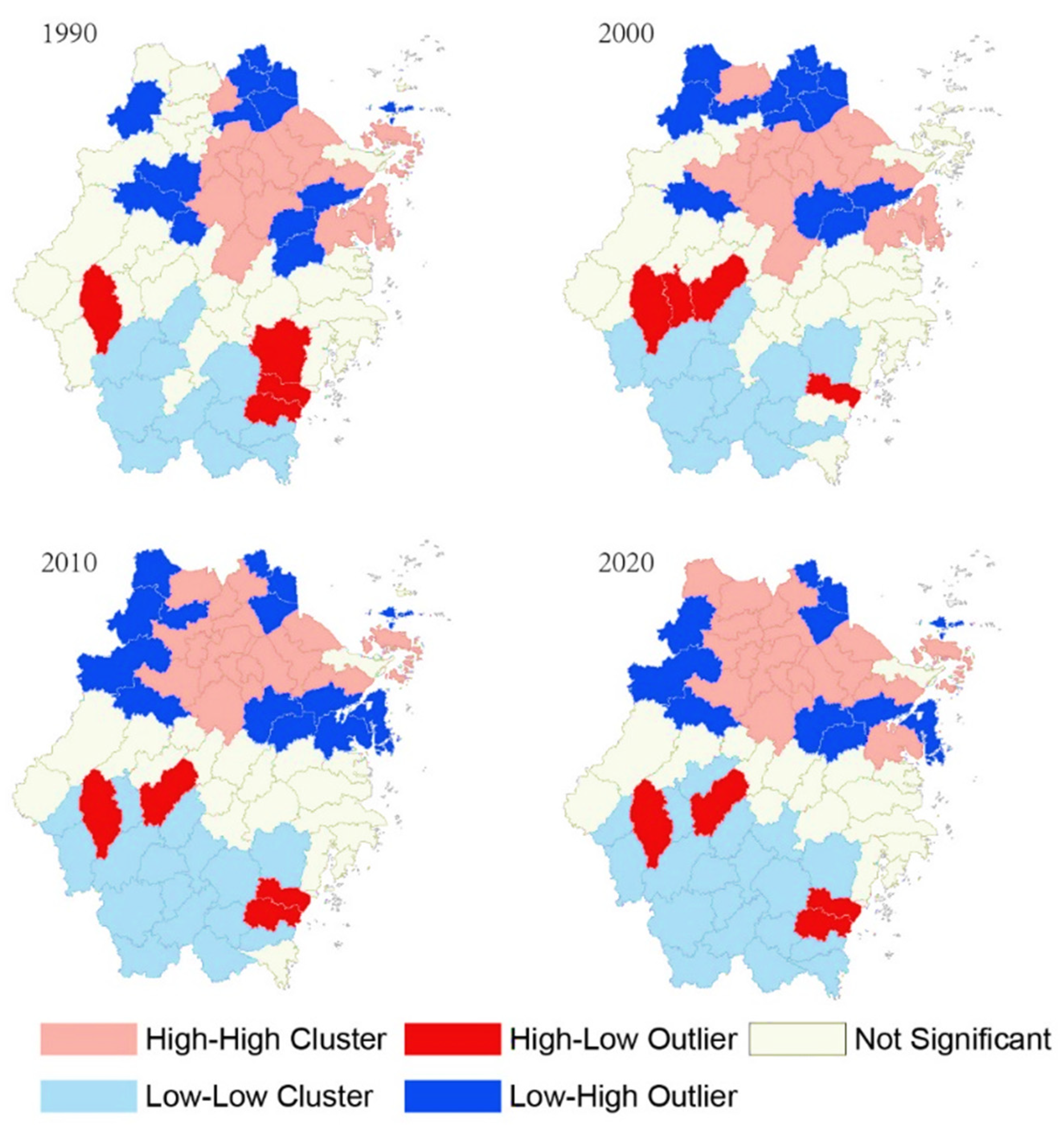
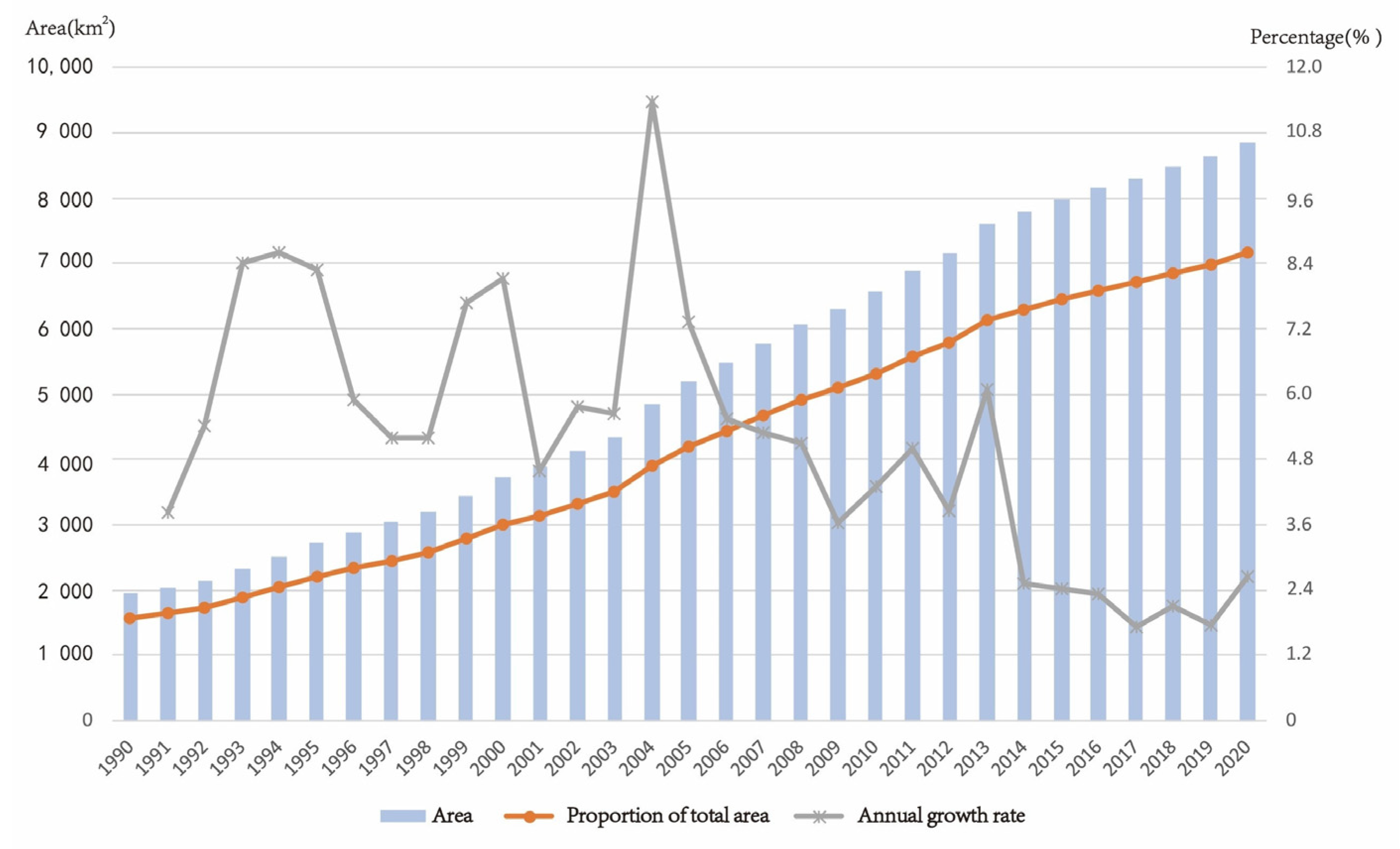
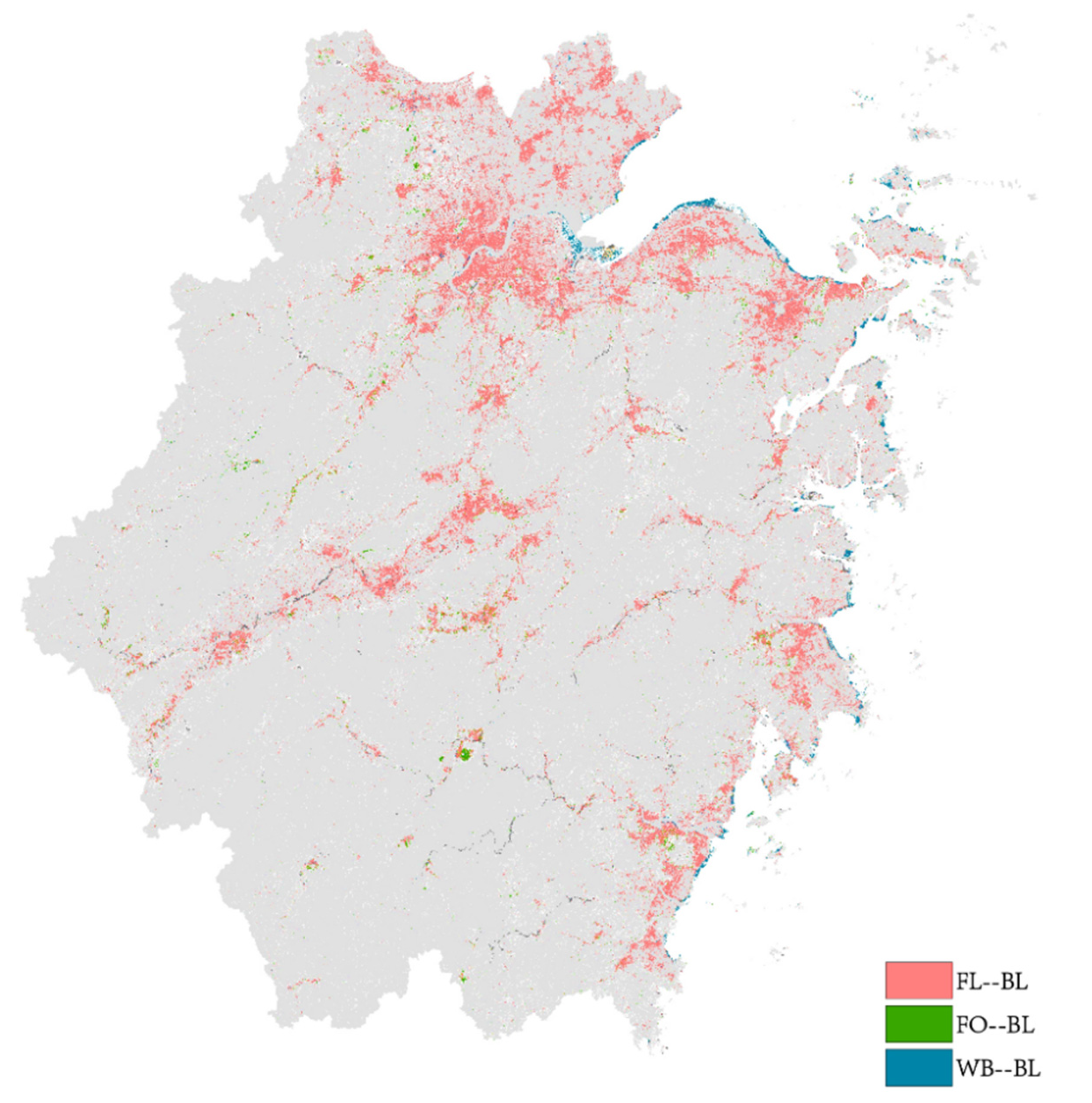

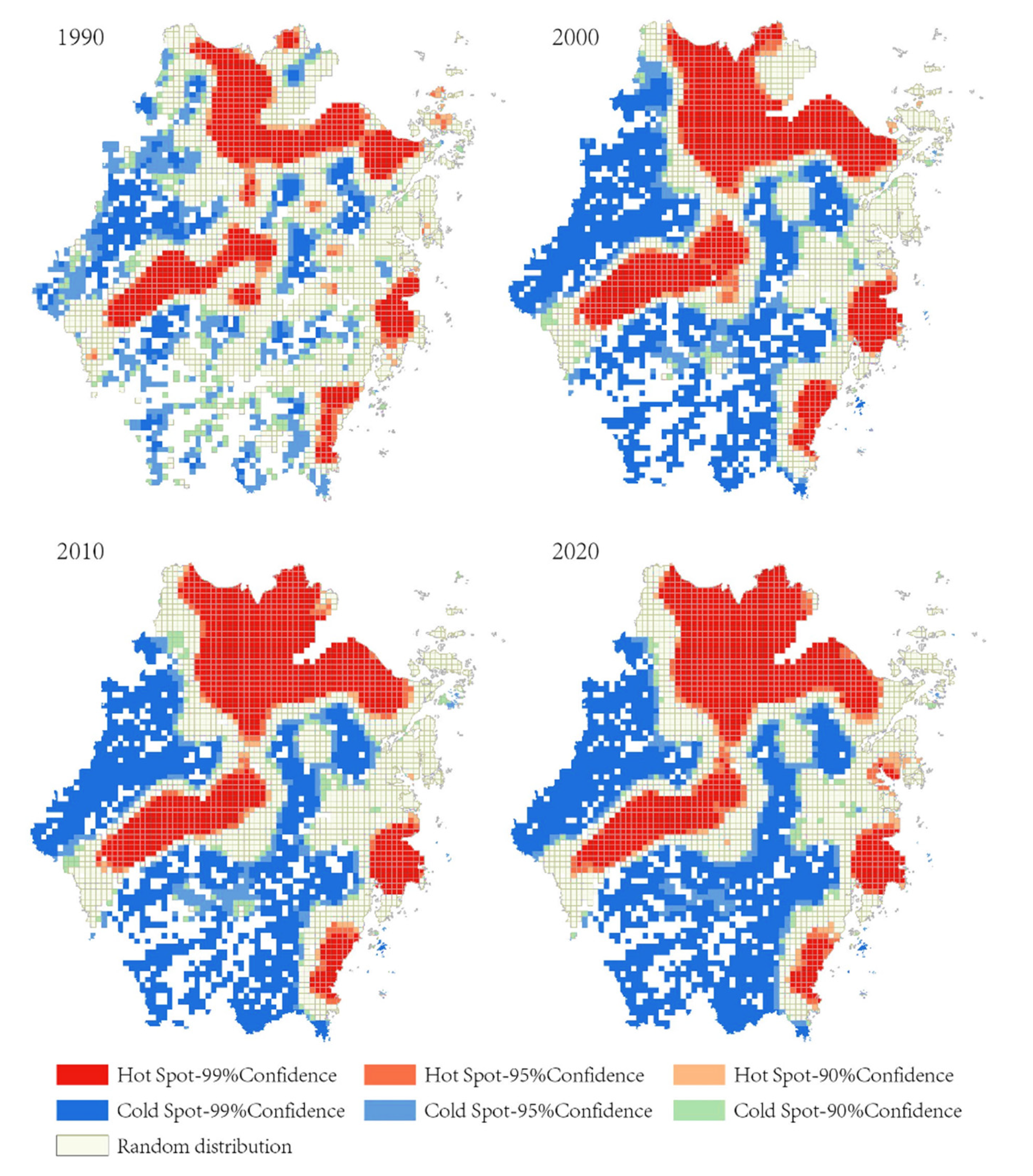
| Variable | Description | Attribute |
|---|---|---|
| BUA | Area of built-up land in the region at year’s end | Explained variable |
| RTP | Region’s total population at year’s end | Explanatory variable |
| GDP | Year-end gross regional product | Explanatory variable |
| STR | The ratio of the value added of the tertiary industry to the secondary industry in that year | Controlled variable |
| FDI | Total foreign direct investment that year | Controlled variable |
| INV | Total investment in fixed assets for that year | Controlled variable |
| LFE | Total local government expenditure for that year | Controlled variable |
| S/No | Year | Moran’s I | Z-Score | p-Value |
|---|---|---|---|---|
| 1. | 1990 | 0.3246 | 4.1720 | 0.000 |
| 2. | 1995 | 0.3336 | 4.2903 | 0.000 |
| 3. | 2000 | 0.3572 | 4.5807 | 0.000 |
| 4. | 2005 | 0.4050 | 5.1487 | 0.000 |
| 5. | 2010 | 0.4233 | 5.3735 | 0.000 |
| 6. | 2015 | 0.4312 | 5.4608 | 0.000 |
| 7. | 2020 | 0.4335 | 5.4827 | 0.000 |
| 1990 2020 | BL | FL | FO | GR | WB | BS | Inflow |
|---|---|---|---|---|---|---|---|
| BL | 1845.74 | 6091.78 | 486.62 | 6.27 | 424.8 | 0.28 | 7009.75 |
| FL | 25.70 | 20,350.41 | 3547.44 | 8.08 | 408.22 | 0.02 | 3989.46 |
| FO | 0.39 | 1502.87 | 65,303.64 | 14.18 | 59.91 | 0 | 1577.35 |
| GR | 0.00 | 1.60 | 3.68 | 3.97 | 0.19 | 0 | 5.47 |
| WB | 84.00 | 713.23 | 24.64 | 0.75 | 2206.76 | 0 | 822.62 |
| BS | 0.07 | 0.66 | 0.2 | 0.04 | 0.79 | 0.01 | 1.76 |
| Outflow | 110.16 | 8310.14 | 4062.58 | 29.32 | 893.91 | 0.3 | - |
| 1990 2000 | BL | FL | FO | GR | WB | BS | Inflow |
|---|---|---|---|---|---|---|---|
| BL | 1901.57 | 1620.21 | 57.96 | 3.83 | 139.01 | 0.14 | 1821.15 |
| FL | 1.91 | 25,033.72 | 1285.4 | 3.4 | 184.68 | 0.03 | 1475.42 |
| FO | 0.13 | 1672.49 | 68,019.22 | 11.6 | 43.15 | 0 | 1727.37 |
| GR | 0 | 2.02 | 0.44 | 14.11 | 0.11 | 0 | 2.57 |
| WB | 52.29 | 332.1 | 3.2 | 0.31 | 2733.68 | 0.02 | 387.92 |
| BS | 0 | 0.01 | 0 | 0.04 | 0.04 | 0.12 | 0.09 |
| Outflow | 54.33 | 3626.83 | 1347 | 19.18 | 366.99 | 0.19 | - |
| 2000 2010 | BL | FL | FO | GR | WB | BS | Inflow |
|---|---|---|---|---|---|---|---|
| BL | 3593.42 | 2598.67 | 177.69 | 1.34 | 193.37 | 0.1 | 2971.17 |
| FL | 9.42 | 21,768.83 | 1502.29 | 2.94 | 223.63 | 0 | 1738.28 |
| FO | 0.15 | 1427.19 | 68,054.95 | 2.96 | 27.46 | 0 | 1457.76 |
| GR | 0.02 | 17.86 | 1.22 | 9 | 0.74 | 0.02 | 19.86 |
| WB | 119.71 | 696.33 | 10.41 | 0.34 | 2675.75 | 0 | 826.79 |
| BS | 0 | 0.26 | 0.03 | 0.1 | 0.65 | 0.09 | 1.04 |
| Outflow | 129.3 | 4740.31 | 1691.64 | 7.68 | 445.85 | 0.12 | - |
| 2010 2020 | BL | FL | FO | GR | WB | BS | Inflow |
|---|---|---|---|---|---|---|---|
| BL | 6514.28 | 2003.43 | 153.2 | 17.34 | 166.44 | 0.8 | 2341.21 |
| FL | 6.9 | 20,676.76 | 3109.57 | 3.56 | 543.02 | 0.06 | 3663.11 |
| FO | 0.07 | 631.91 | 66,244.91 | 1.97 | 2.13 | 0 | 636.08 |
| GR | 0 | 1.81 | 1.85 | 5.64 | 0.1 | 0.04 | 3.8 |
| WB | 43.33 | 193.1 | 3.18 | 0.07 | 2789.7 | 0 | 239.68 |
| BS | 0.01 | 0.1 | 0 | 0.28 | 1.15 | 0.23 | 1.54 |
| Outflow | 50.31 | 2830.35 | 3267.8 | 23.22 | 712.84 | 0.9 | - |
| S/No | Test | Statistic | p-Value |
|---|---|---|---|
| 1. | LM-lag | 137.18 | 0.000 |
| 2. | LM-error | 119.55 | 0.000 |
| 3. | RLM-lag | 26.97 | 0.000 |
| 4. | RLM-error | 9.35 | 0.002 |
| 5. | Wald spatial lag | 12.42 | 0.053 |
| 6. | Wald spatial error | 19.09 | 0.004 |
| 7. | Hausman | 890.4 | 0.000 |
| Variables | SLM | SEM | SDM | |||
|---|---|---|---|---|---|---|
| ln RTP | 0.4707 *** | 0.4652 *** | 0.4911 *** | 0.4759 *** | 0.5134 *** | 0.4749 *** |
| (19.8720) | (19.6014) | (20.7455) | (20.1474) | (21.5537) | (20.3221) | |
| ln GDP | 0.4264 *** | 0.4482 *** | 0.3979 *** | 0.4259 *** | 0.3733 *** | 0.4356 *** |
| (13.3723) | (14.1929) | (12.5133) | (13.4061) | (11.6445) | (13.7442) | |
| ln STR | −0.1514 *** | −0.1498 *** | −0.1523 *** | −0.1442 *** | −0.1627 *** | −0.1497 *** |
| (−6.2092) | (−6.1210) | (−6.3748) | (−5.9100) | (−6.8745) | (−6.2418) | |
| ln FDI | 0.0175 *** | 0.0184 *** | 0.0251 *** | 0.0215 *** | 0.0248 *** | 0.0239 *** |
| (5.0767) | (5.3312) | (7.3162) | (6.2406) | (7.2353) | (6.9654) | |
| ln INV | 0.0822 *** | 0.0753 *** | 0.1071 *** | 0.0957 *** | 0.1159 *** | 0.0939 *** |
| (3.6273) | (3.3155) | (4.7723) | (4.2127) | (5.1904) | (4.1643) | |
| ln LFE | 0.0017 * | −0.0059 | −0.0249 | −0.0195 | −0.0214 | −0.0382 |
| (0.0614) | (−0.2155) | (−0.9122) | (−0.7111) | (−0.7936) | (−1.4072) | |
| 0.0450 *** | 0.0038 | 0.1825 *** | 0.0899 *** | |||
| (3.4814) | (0.2698) | (6.4360) | (2.9544) | |||
| 0.2342 *** | 0.1242 *** | |||||
| (8.3384) | (4.0201) | |||||
| W˟ ln RTP | −0.3923 *** | −0.0999 * | ||||
| (−7.6983) | (−1.8725) | |||||
| W˟ ln GDP | 0.3158 *** | 0.1323 ** | ||||
| (5.3028) | (1.9894) | |||||
| W˟ ln STR | −0.0122 | −0.2747 *** | ||||
| (−0.2362) | (−4.3859) | |||||
| W˟ ln FDI | −0.0347 *** | −0.0361 *** | ||||
| (−6.5144) | (−6.0072) | |||||
| W˟ ln INV | −0.2343 *** | −0.3049 *** | ||||
| (−5.6002) | (−7.2419) | |||||
| W˟ ln LFE | 0.1220 *** | 0.2691 *** | ||||
| (2.7406) | (5.4943) | |||||
| R-squared | 0.8975 | 0.8969 | 0.8965 | 0.8968 | 0.9053 | 0.9033 |
| logLik | −580.02 | −586.07 | −579.3 | −583.1 | −508.75 | −522.90 |
| Variables | Effect | ||
|---|---|---|---|
| RTP | Direct effect | 0.4999 *** | 0.4738 *** |
| Indirect effect | −0.3517 *** | −0.0616 | |
| Total | 0.1481 ** | 0.4121 *** | |
| GDP | Direct effect | 0.3907 *** | 0.4392 *** |
| Indirect effect | 0.4521 *** | 0.1848 ** | |
| Total | 0.8428 *** | 0.6240 *** | |
| STR | Direct effect | −0.1646 *** | −0.1558 *** |
| Indirect effect | −0.0493 | −0.3105 *** | |
| Total | −0.2139 *** | −0.4663 *** | |
| FDI | Direct effect | 0.0234 *** | 0.0232 *** |
| Indirect effect | −0.0356 *** | −0.0366 *** | |
| Total | −0.0122 * | −0.0134 * | |
| INV | Direct effect | 0.1063 *** | 0.0877 *** |
| Indirect effect | −0.2510 *** | −0.3195 *** | |
| Total | −0.1447 *** | −0.2318 *** | |
| LFE | Direct effect | −0.0160 | −0.0326 |
| Indirect effect | 0.1391 *** | 0.2863 *** | |
| Total | 0.1230 ** | 0.2537 *** |
| Impact | Variables | Period 1 | Period 2 | Period 3 | |||
|---|---|---|---|---|---|---|---|
| Direct | RTP | 0.5581 *** | (9.8126) | 0.5732 *** | (14.1177) | 0.3202 *** | (9.4878) |
| GDP | 0.3328 *** | (4.7707) | 0.3273 *** | (5.7846) | 0.5697 *** | (11.8805) | |
| STR | −0.0886 * | (−1.8059) | −0.2198 *** | (−4.6461) | −0.2291 *** | (−6.0449) | |
| FDI | 0.0312 *** | (4.1615) | 0.0235 *** | (3.8268) | 0.0056 | (1.2303) | |
| INV | −0.0101 | (−0.2292) | 0.1680 *** | (4.0663) | 0.2092 *** | (5.3840) | |
| LFE | 0.1377 ** | (2.4588) | −0.0142 | (−0.2812) | −0.1998 *** | (−5.1106) | |
| Indirect | RTP | −0.4612 *** | (−3.9602) | −0.4828 *** | (−5.0578) | −0.2187 *** | (−2.8069) |
| GDP | 0.4583 *** | (3.6465) | 0.5724 *** | (4.9238) | 0.3063 *** | (2.7415) | |
| STR | 0.0127 | (0.1189) | −0.0486 | (−0.4587) | −0.1614 * | (−1.7700) | |
| FDI | −0.0339 *** | (−2.8280) | −0.0218 ** | (−2.2731) | −0.0427 *** | (−5.2393) | |
| INV | −0.2090 ** | (−2.5069) | −0.3233 *** | (−3.7662) | −0.1685 ** | (−1.9811) | |
| LFE | 0.2122 ** | (2.3341) | 0.0915 | (1.1271) | 0.0939 | 1.2367 | |
| Total | RTP | 0.0969 | (0.7706) | 0.0904 | (0.8094) | 0.1015 | (1.1607) |
| GDP | 0.7911 *** | (5.1467) | 0.8996 *** | (6.2795) | 0.8760 *** | (6.7652) | |
| STR | −0.0759 | (−0.5903) | −0.2684 ** | (−2.0348) | −0.3905 *** | (−3.4963) | |
| FDI | −0.0028 | (−0.2302) | 0.0018 | (0.1793) | −0.0370 *** | (−3.7839) | |
| INV | −0.2191 ** | (−2.1432) | −0.1554 | (−1.4314) | 0.0407 | (0.3862) | |
| LFE | 0.3499 ** | (3.1393) | 0.0773 | (0.7584) | −0.1058 | (−1.2777) | |
| Effect | Variables | Mountain Counties | Non-Mountain Counties | ||
|---|---|---|---|---|---|
| Direct | RTP | −0.1373 ** | (−2.1105) | 0.6658 *** | (22.8801) |
| GDP | 0.9993 *** | (13.3176) | 0.1332 *** | (3.3940) | |
| STR | −0.2450 *** | (−4.8359) | −0.1132 *** | (−4.8835) | |
| FDI | −0.0031 | (−0.8665) | 0.0387 *** | (5.6740) | |
| INV | 0.2100 *** | (4.8196) | 0.0484 ** | (2.1405) | |
| LFE | −0.1006 | (−1.4397) | 0.1484 *** | (5.1641) | |
| Indirect | RTP | −2.3069 *** | (−13.0832) | 0.1196 *** | (2.3751) |
| GDP | 1.8255 *** | (8.9773) | −0.0133 | (−0.2050) | |
| STR | 0.7760 *** | (7.1357) | 0.0375 | (0.9700) | |
| FDI | 0.0092 | (1.1876) | −0.0333 *** | (−3.8902) | |
| INV | 0.1697 * | (1.7918) | −0.0402 | (−1.1176) | |
| LFE | −0.0349 | (−0.2186) | 0.0397 | (0.8658) | |
| Total | RTP | −2.4441 *** | (−11.1999) | 0.7855 *** | (12.2975) |
| GDP | 2.8248 *** | (11.3043) | 0.1199 | (1.4478) | |
| STR | 0.5311 ** | (3.9508) | −0.0757 * | (−1.6488) | |
| FDI | 0.0061 | (0.6882) | 0.0054 | (0.5518) | |
| INV | 0.3796 *** | (3.4487) | 0.0082 | (0.2167) | |
| LFE | −0.1355 | (−0.6738) | 0.1881 *** | (4.0529) | |
Publisher’s Note: MDPI stays neutral with regard to jurisdictional claims in published maps and institutional affiliations. |
© 2022 by the authors. Licensee MDPI, Basel, Switzerland. This article is an open access article distributed under the terms and conditions of the Creative Commons Attribution (CC BY) license (https://creativecommons.org/licenses/by/4.0/).
Share and Cite
Wu, Y.; Han, Z.; Faisal Koko, A.; Zhang, S.; Ding, N.; Luo, J. Analyzing the Spatio-Temporal Dynamics of Urban Land Use Expansion and Its Influencing Factors in Zhejiang Province, China. Int. J. Environ. Res. Public Health 2022, 19, 16580. https://doi.org/10.3390/ijerph192416580
Wu Y, Han Z, Faisal Koko A, Zhang S, Ding N, Luo J. Analyzing the Spatio-Temporal Dynamics of Urban Land Use Expansion and Its Influencing Factors in Zhejiang Province, China. International Journal of Environmental Research and Public Health. 2022; 19(24):16580. https://doi.org/10.3390/ijerph192416580
Chicago/Turabian StyleWu, Yue, Zexu Han, Auwalu Faisal Koko, Siyuan Zhang, Nan Ding, and Jiayang Luo. 2022. "Analyzing the Spatio-Temporal Dynamics of Urban Land Use Expansion and Its Influencing Factors in Zhejiang Province, China" International Journal of Environmental Research and Public Health 19, no. 24: 16580. https://doi.org/10.3390/ijerph192416580
APA StyleWu, Y., Han, Z., Faisal Koko, A., Zhang, S., Ding, N., & Luo, J. (2022). Analyzing the Spatio-Temporal Dynamics of Urban Land Use Expansion and Its Influencing Factors in Zhejiang Province, China. International Journal of Environmental Research and Public Health, 19(24), 16580. https://doi.org/10.3390/ijerph192416580






